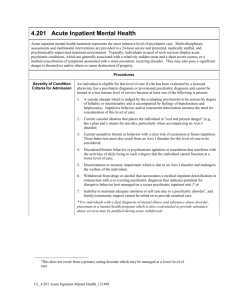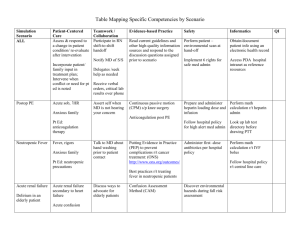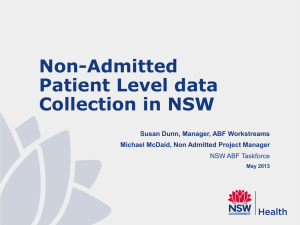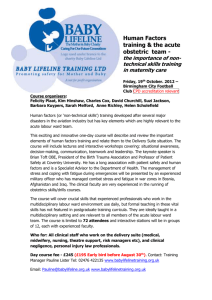Central Mental Health Clinical Cluster (large file)
advertisement
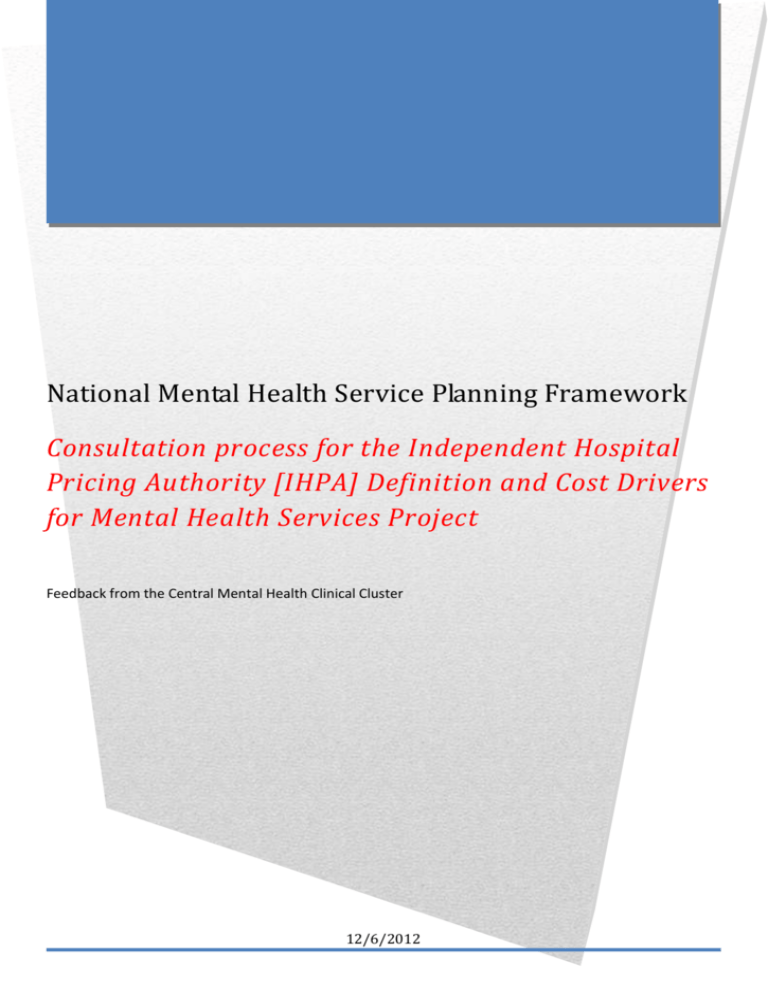
National Mental Health Service Planning Framework Consultation process for the Independent Hospital Pricing Authority [IHPA] Definition and Cost Drivers for Mental Health Services Project Feedback from the Central Mental Health Clinical Cluster 12/6/2012 1. National Mental Health Care Type • Under the current system, all admitted patients are classified to a Care Type at hospital admission eg, Acute care. The current system also allows a change of Care Type within a single hospital stay eg, inpatient. • This same approach could be adopted for mental health. This would require the boundary between mental health and other care to be carefully defined. Consultation Question 1 Is a Mental Health Care Type the best way of encompassing those admitted services that should form part of a new national mental health classification? If not, what alternative would you propose? The challenge is that we operate predominantly statewide as an integrated service. Rehabilitation and acute care are two types [one acute and one less acute] How does this sit across the age ranges? The paper does acknowledge that Victoria has a series of care types. How do they operationalise them? One of the risks with ABF is not being able to claim payment for CL services. We don’t want to lose the services as has nearly happened in Victoria. Still some grey areas which aren’t reflected terribly well. Also could look at a patient based care type which provides more flexibility when looking at complexity rather than facility based service types- for example, an acute care type that reflects a high support level or complex need, that could be applied for any individual in a range of settings, where acute services are required such as inpatient, home based acute care, and in some cases CCU / MSU’s / MIRT services, and occasionally in case management teams where Case manager, GP, Family, NGHO supports may be providing 24 hour care and support as a strategy to avoid admission. Acute care is not only provided in hospital inpatient settings- need a system that supports appropriate funding related to need and complexity in a flexible range of environments| In our current system, after a 35 day inpatient admission, you are no longer considered acute unless an extension is secured via an acute care certificate. If the patient can pay at this point they do. Some mental health inpatients are not acute and are not rehabilitation, but still require admission for a range of issues. These could possibly be considered ‘sub-acute’ We already have robust definitions of care type, what we need is to work out what is inscope and out of scope. It is important to clarify the identified care type for high risks inpatient clients who require "specials" to ensure we capture appropriate funding - for either medical or mental health reasons. Funding arrangements are complex due to care being provided across the continuum as per an in targeted MHS model. To assist with this complexity a MH Care type is a good way of encompassing admitted service for Mental Health, it will still need to differentiate between acute and subacute MH Services 2. Establishing criteria for the definition of services within a national mental health Care Type The first key question to resolve is whether the definition of mental health services is based on: This section largely focused on inpatient care. a) The service. Under this approach, a set of ‘mental health services’ would be defined as being in-scope for the mental health classification. b) The patient. Under this approach, all services provided to patients with a primary mental health diagnosis would be defined as being in-scope Consultation Question 2 What should be the criterion, or criteria, for the definition of services within a national mental health Care Type? Agreement reached that the definition should be based on ‘The service’. Under this approach, a set of ‘mental health services’ would be defined as being in-scope for the mental health classification. There is obvious value in it being patient driven but for ABF needs to be service driven ABF is funded on the separation Physical and mental illnesses need to be of equal importance Identified in the community FTE profile | not as complex in a hospital environment however where you try to do this is in the community it becomes difficult Sitting in a hospital general ward how are you going to get the funding for mental health intervention? MH-CASC [Mental Health Classification and Service Cost], an imitative of the national MH reform agenda looking at DRG this is one of the issues that came up www.health.gov.au/internet/main/publishing.nsf/content/.../ben8.pdf People end up staying in hospital for reasons other than illness If there is no community infrastructure then length of stay increases Social determinants Changes to extended treatment for adolescents this will impact on these definitions Need to clarify if ABF funding on separation is appropriate for MHS. Rather SMHRU/CCU should be funding every quarter based on accrued OBDs. 3. Applying the definition of ‘mental health services’ to community-based mental health services It is critical that the definition of mental health is equally appropriate to community mental health. What community-based mental health services should be defined as mental health services for casemix classification purposes? Government based services which provide treatment Goes under the specialised mental health services currently provided by public and private sectors umbrella not NGO Need clarification on identified care type for high risks inpatient clients who require "specials" to ensure we capture appropriate funding - for either medical or mental health reasons. Funding arrangements are complex due to care being provided across the continuum as per an in targeted MHS model. To assist with this complexity a MH Care type is a good way of encompassing admitted service for Mental Health, it will still need to differentiate between acute and subacute MH Services. Will the data captured via CIMHA be readily accessible to the Health Statistic centre for National reporting 4. Defining primary mental health services delivered by public hospitals • The National Health Reform Agreement (NHRA) specifies that primary health services are out of scope for ABF as the Commonwealth has the lead funding and program responsibility for these services. However the NHRA does not define primary health services and so it is important the definitions recommended by this project can delineate what, if any, primary mental health services hospitals may deliver. • As a result a definition of primary mental health services specifically for NMHSPF purposes was developed, this being: • “...health care services aimed at early detection and treatment of mental health problems and the maintenance of mental health, that are delivered to nominated individuals (or groups of individuals), usually in community settings, within a service model where mental health problems are identified and managed as part of a broader range of health care to a population.” Are there any services that are provided by specialised mental health units or programs that can be considered primary mental health? COPMI (Children of Parents with Mental Illness) | National initiative http://www.copmi.net.au/ Peri natal work https://www.mja.com.au/journal/2009/191/5/national-approach-perinatal-mental-health-australiaexercising-caution-roll-out?0=ip_login_no_cache%3D6fe312ac9a2778613dded80e26bfbcdf Ed-LinQ http://education.qld.gov.au/studentservices/natural-disasters/resources/attachment-d-edlinqoverview.pdf Primary care teams in Victoria | http://www.health.vic.gov.au/mentalhealth/services/adult/ GPLO – about shared care http://www.apcc.org.au/about_the_APCC/apcc_team/lifestyle-risk-modification-expert-referencepanel/ Activate mind and body http://www.activatemindandbody.com.au/ 5. Services for people whose primary problem is an alcohol or drug-related disorder • The delivery structure of alcohol and drug treatment (AODT) services varies across jurisdictions and across services within jurisdictions. In some places mental health and AODT services are managed by the same organisational unit, and in others AODT services are provided predominantly outside the hospital setting • Should the mental health classification include alcohol and drug-related disorders? • If so, is it the diagnosis or specialised treatment setting that is used as the decisive criterion for inclusion in the definition Consultation Questions 1. Should the mental health classification include alcohol and drug-related disorders? Consensus to move towards dual diagnosis but not single diagnosis which is not to say that ADS services are not provided at SC but rarely as a primary diagnosis from MH services. Sunshine Coast Alcohol and drug services continue to sit in primary and community health care with predominantly NGO providers From a MH classification in a broader sense, because the paper does recognise difference in treatment, but they are not necessarily mental health services. Primary alcohol and drug problems 16 of the 17 MHS in Qld have ADS Mental Health Commission will have an ADS Very much part of core business administratively What are the funding implications if they are not included? Preference Mental Health and Alcohol and Drug 2. If so, is it the diagnosis or specialised treatment setting that is used as the decisive criterion for inclusion in the definition? Specialised 6. Classifying specialised ‘non-acute’ bed-based mental health services. Consultation Question • Should long-term non-acute bed-based clinically-staffed mental health public hospital services be classed as residential, admitted mental health or admitted maintenance care? • Admitted mental health 7. Setting the boundary with aged inpatient Care Types Should the Psychogeriatric Care Type continue to exist or should all of the mental health care of older people be defined as Mental Health for classification purposes? Really about definitions Mental health should look after mental health and someone else should look after Get admitted based on mental health problem rather than age. Need clarification on identified care type for high risks inpatient clients who require "specials" to ensure we capture appropriate funding - for either medical or mental health reasons. Funding arrangements are complex due to care being provided across the continuum as per an in targeted MHS model. To assist with this complexity a MH Care type is a good way of encompassing admitted service for Mental Health, it will still need to differentiate between acute and subacute MH Services. 8. Emergency Department care for patients with a mental disorder The key issue to be resolved is whether mental health care in the ED is defined as ED or Mental Health for casemix classification purposes. A subset issue is whether a different approach is taken if the care is delivered by ED staff or by specialist mental health staff who attend the ED for the purposes of seeing the patient. Should mental health care in the emergency department (ED) be defined as ED or Mental Health for classification purposes? If mental health encompasses emergency department care services, how should these services be classified (e.g., diagnosis based on MDCs?) General consensus that mental health care in the emergency department (ED) should be defined as ED How do we get paid for our intervention? Needs to be identified in the Acute Care Response | Do the assessment where the person is This is one of the advantages of care type going across settings 9. Jurisdictional differences in the reporting of mental health services in the mental health patient-level NMDSs There are jurisdictional differences in the way mental health services are currently classified and reported. One example is hospital in the home (HITH). For example, Flinders Medical Centre in South Australia provides a HITH program to care for mental health patients in their home either as a hospital avoidance program or after discharge from hospital. HITH services are classed as admitted and reported to the admitted patient mental health care NMDS. Consultation Question Are there other examples of care models or pathways that are broadly similar, but are classified differently by jurisdictions in the mental health patient-level NMDSs? Difficulty with hospital in the home is just badged continuing care To meet the National insurance definition and legislation it does not include supported accommodation For Qld, MH services provide treatment where the person is through the service delivery framework which would and could include the home. Looking at hospital avoidance after discharge Integrated service delivery model Where does home and outreach sit? Not about resources Some will fund alternatives to inpatient care because it is cheaper 10. New data elements needed in current NMDSs to enable the development and implementation of a mental health service classification framework The mental health NMDSs have changed little since their introduction many years ago. The CMHC NMDS is particularly basic, containing little information on the nature of the service events that are at its core. For example, a number of service characteristics that would assist classification are Examples of these absent variables include the time of day of service events, the number of clinicians attending and their discipline, the treatment provided at each event, where the event occurred, whether the event required an interpreter or not, and how many clients were in attendance for group therapy sessions Consultation Question How should current mental health NMDSs be adapted to facilitate the implementation of a mental health service classification without adding to the data collection burden that services and clinicians currently? Outcomes readiness To some degree Qld has progressed this with CIMHA so other states should really come up to our level




